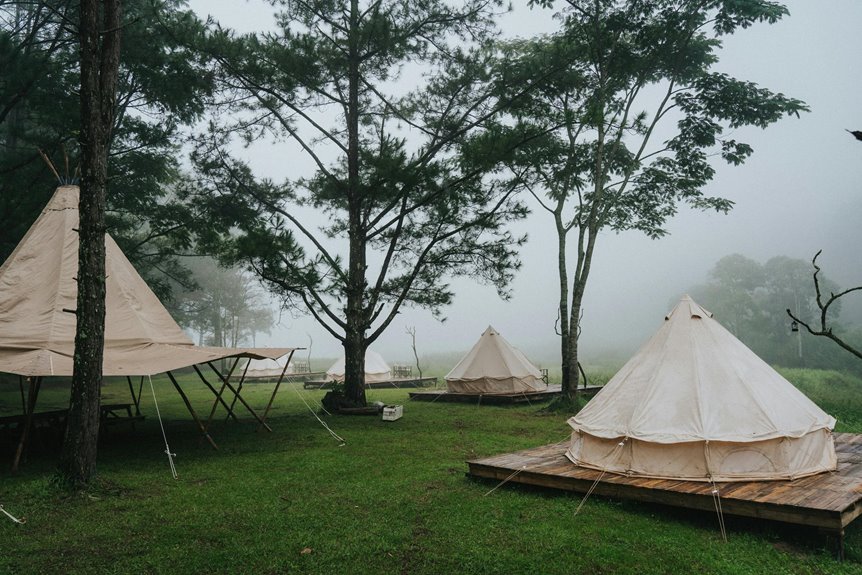If you want a tent that offers better breathability, durability, and comfort, polycotton tents are a solid choice. They handle humidity and weather well but do weigh more and demand more care to avoid mildew. While pricier upfront, their long lifespan can make them a better investment than standard synthetic tents. You’ll also find they suit moderate climates best. Keep exploring to understand how their advantages and drawbacks fit your camping style.
Table of Contents
Key Takeaways
- Polycotton tents offer superior breathability and comfort, reducing condensation compared to standard synthetic tents.
- They provide enhanced durability and better resistance to UV exposure and heavy rain than many standard tents.
- Polycotton tents are heavier and bulkier, making them less ideal for long hikes but suitable for car camping.
- Higher initial cost and maintenance, including cleaning and waterproofing, are trade-offs for their longer lifespan.
- Environmentally, polycotton blends reduce reliance on pure synthetics, offering a more sustainable option with natural fiber benefits.
What Is Polycotton Fabric?
Polycotton fabric blends polyester and cotton fibers to combine the strengths of both materials. When you choose polycotton, you get the durability and wrinkle resistance of polyester alongside the softness and natural feel of cotton.
This blend creates a fabric that’s tougher than pure cotton but more breathable than 100% polyester. It holds dye well, so colors stay vibrant longer, and it resists shrinking better than cotton alone.
You’ll also find polycotton dries faster than pure cotton, making it practical for outdoor gear like tents. Because it balances strength and comfort, polycotton is popular in products that need to endure wear while still feeling pleasant to touch.
Understanding this fabric’s makeup helps you see why it’s an attractive option for tent materials.
Breathability and Comfort Comparison
You want a tent that keeps moisture at bay and lets fresh air flow freely, right?
Polycotton tents excel at managing humidity and providing ventilation, which helps regulate temperature better than many standard tents.
Let’s explore how these features impact your comfort during camping.
Moisture Management Efficiency
Although moisture management might seem like a minor detail, it plays an essential role in your overall comfort inside a tent.
Polycotton tents excel here due to their natural fibers that absorb and release moisture more effectively than standard synthetic tents. This means you’re less likely to wake up to dampness.
Here’s why moisture management matters:
- Polycotton absorbs sweat, reducing condensation buildup inside.
- It releases trapped moisture gradually, preventing a clammy interior.
- Standard tents often trap moisture, causing discomfort and potential mildew.
- Efficient moisture management helps regulate internal humidity, enhancing sleep quality.
Choosing a tent with superior moisture management guarantees you stay dry and comfortable, even in humid conditions, making your camping experience much more enjoyable.
Airflow and Ventilation
Managing moisture inside your tent sets the stage for how well air flows through it. When you choose a polycotton tent, you benefit from fabric that’s naturally breathable, allowing air to circulate more freely.
This breathability helps reduce stuffiness, so you’ll feel more comfortable inside, especially on humid nights. Standard tents, often made from synthetic materials like nylon or polyester, tend to trap heat and moisture, which can cause condensation buildup and a damp environment.
You might find yourself needing to unzip vents or doors more often to improve airflow. With polycotton, the fabric’s porous nature works passively to keep air moving without compromising protection.
Temperature Regulation Benefits
When temperatures rise or drop, the fabric of your tent plays a crucial role in keeping you comfortable. Polycotton tents excel in temperature regulation thanks to their breathable nature, allowing moisture and heat to escape more effectively than synthetic-only tents.
Here’s how this benefits you:
- Enhanced Breathability: Polycotton fibers let air circulate naturally, reducing stuffiness inside your tent.
- Better Insulation: The fabric traps warmth during chilly nights, keeping you cozy without overheating.
- Moisture Management: It absorbs and releases moisture efficiently, preventing dampness and condensation buildup.
- Comfortable Climate: Overall, you experience a more stable and pleasant environment, regardless of external weather extremes.
This balance makes polycotton tents ideal if you want comfort across variable temperatures.
Durability and Weather Resistance
Durability plays an essential role in choosing between polycotton and standard tents, especially if you camp frequently or in challenging conditions.
Polycotton tents are known for their robust fabric, combining cotton’s strength with polyester’s resilience. This blend resists wear and tear better than many standard synthetic tents, which might degrade faster under UV exposure.
Polycotton tents blend cotton’s strength with polyester’s durability, outlasting many standard synthetics under UV exposure.
You’ll find polycotton tents handle heavy rain well, thanks to their breathability that reduces condensation inside. However, they require proper waterproofing treatment to maintain weather resistance.
On the other hand, standard tents made from nylon or polyester often use coatings that offer immediate waterproof protection but can lose durability over time.
If you want a tent that stands up to rough use and varying weather, polycotton’s durability and weather resistance might give you an edge.
Weight and Portability Considerations
Although polycotton tents offer impressive strength, they tend to weigh more than standard nylon or polyester tents, which can impact your packing and carrying choices.
When considering weight and portability, keep these points in mind:
- Heavier weight means you’ll carry more load, which can tire you faster on long hikes.
- Bulkier packing size may limit space in your backpack or vehicle.
- You might need sturdier stakes and poles, adding to overall weight.
- For car camping or short treks, the extra weight is less of a drawback and offers more comfort.
If you prioritize lightweight gear for extended trips, standard tents might suit you better, but for durability with manageable bulk, polycotton tents remain a solid choice.
Maintenance and Cleaning Requirements
Carrying the extra weight of a polycotton tent means you’ll likely use it in conditions where longevity and comfort matter more.
When it comes to maintenance, polycotton requires a bit more care than standard synthetic tents. You’ll want to keep it dry and clean to prevent mold and mildew since the natural fibers absorb moisture more readily. After each trip, brush off dirt and let it air dry completely before storing.
Cleaning polycotton tents means using mild soap and cold water—avoid harsh detergents that can damage the fabric’s waterproof coating.
In contrast, standard tents made from nylon or polyester usually clean up faster and dry quicker, making them easier for frequent use or quick turnarounds.
With proper care, your polycotton tent will stay comfortable and durable for many seasons.
Cost Differences Between Polycotton and Standard Tents
When you’re choosing between polycotton and standard tents, cost is a key factor to evaluate.
You’ll notice differences not just in the initial purchase price, but also in long-term value and upkeep expenses.
Understanding these cost aspects will help you make a smarter investment for your camping needs.
Initial Purchase Price
Because polycotton tents use a blend of natural and synthetic fibers, they tend to cost more upfront than standard tents made from pure synthetic materials.
When you’re deciding which tent to buy, consider these factors affecting the initial price:
- Material cost: Polycotton fabric is pricier due to its hybrid nature.
- Manufacturing complexity: Blended fabrics require more intricate processing.
- Brand positioning: Polycotton tents often target premium markets.
- Design features: Many polycotton tents include enhanced ventilation or durability improvements, adding to the cost.
If budget constraints matter, standard synthetic tents usually offer a more affordable entry point.
However, you’ll pay that lower price for less natural fabric feel and potentially different performance characteristics.
Understanding this price gap helps you make a choice aligned with your camping needs and initial spending willingness.
Long-Term Value
While polycotton tents may require a higher initial investment compared to standard synthetic tents, their long-term value often justifies the upfront cost.
When you consider durability, polycotton tends to last longer because its blend resists wear and tear better than many synthetics. This means you won’t need to replace your tent as frequently, saving money over time.
Additionally, polycotton’s natural breathability can improve comfort during extended use, potentially reducing the need for additional ventilation gear.
While synthetic tents might save you money initially, you could end up spending more replacing or upgrading them.
Maintenance and Repair Costs
Although polycotton tents often come with higher upfront costs, their maintenance and repair expenses can differ markedly from those of standard synthetic tents. You might find that polycotton requires more careful upkeep but repairs could be less frequent or simpler.
Consider these points:
- Polycotton’s natural fibers may need regular cleaning and waterproofing treatments, increasing routine maintenance costs.
- Synthetic tents resist mold and mildew better, reducing cleaning frequency and potential fabric degradation.
- Repairing tears in polycotton can be easier with standard sewing techniques, potentially lowering repair costs.
- Synthetic materials might require specialized patches or adhesives, which can be more expensive and time-consuming.
Ultimately, your choice affects both ongoing maintenance and repair budgets, so weigh these factors carefully.
Environmental Impact and Sustainability
When you choose a tent, its environmental impact should matter as much as its durability or price. Polycotton tents blend natural cotton with polyester, reducing reliance on 100% synthetic materials that rely heavily on fossil fuels. This mix means you lower your carbon footprint compared to pure polyester tents.
Cotton in polycotton is biodegradable, so when your tent reaches the end of its life, it breaks down more naturally than fully synthetic fabrics. However, cotton farming can use significant water and pesticides, so consider tents made from sustainably sourced cotton.
On the other hand, standard polyester tents require less water and pesticides but don’t biodegrade easily, creating long-term waste. Choosing polycotton helps you support a balance between synthetic durability and natural material sustainability, making your camping gear more eco-conscious.
Ideal Camping Conditions for Polycotton Tents
Since polycotton tents combine the breathability of cotton with the strength of polyester, they perform best in moderate weather conditions.
You’ll find them ideal when camping in temperate climates where rain and sun exposure are balanced.
Here’s when you should consider using a polycotton tent:
- Mild to warm temperatures, where ventilation prevents overheating.
- Light to moderate rainfall, as polycotton handles moisture better than pure cotton.
- Low wind conditions, since these tents aren’t as lightweight or aerodynamic as some synthetics.
- Campsites with natural shade, reducing prolonged direct sun exposure that can degrade materials.
User Experiences and Expert Opinions
Understanding the ideal conditions for polycotton tents helps set realistic expectations, but hearing from those who’ve used them adds valuable insight.
Many campers praise polycotton tents for their breathability and comfort, noting less condensation inside compared to standard polyester tents. However, some users mention the extra weight and longer drying times as downsides, especially when packing light or facing sudden rain.
Experts often highlight polycotton’s durability and thermal regulation, making it a solid choice for extended trips and varied climates. On the flip side, they caution about maintenance needs and recommend thorough drying to prevent mildew.
Frequently Asked Questions
Can Polycotton Tents Be Easily Repaired in the Field?
You can repair polycotton tents in the field, but it takes some effort since the fabric is thicker than nylon. Carry heavy-duty patches and strong adhesive; they’ll help you fix tears and keep your shelter secure.
Do Polycotton Tents Require Special Storage Methods?
You don’t have to treat polycotton tents like fragile glass, yet you can’t just toss them in any spot. You’ll want to store them dry and cool to keep their breathability and durability intact.
Are Polycotton Tents Compatible With Standard Tent Accessories?
You’ll find polycotton tents usually work well with standard tent accessories like stakes and poles. Just double-check sizes and attachment points to guarantee everything fits snugly and functions properly during your camping trips.
How Do Polycotton Tents Perform in Extreme Cold Conditions?
You’ll find polycotton tents perform well in extreme cold by retaining heat better than synthetic fabrics. They resist condensation, keeping you drier and warmer, but they can be heavier and require more care to stay durable in harsh conditions.
Can Polycotton Tents Be Used for Long-Term Camping Setups?
Did you know polycotton tents can last over 5 years with proper care? You can definitely use them for long-term camping setups since they offer durability, breathability, and resistance to mold, making extended stays more comfortable.
- Does Chiffon Fabric Stink - July 15, 2025
- Does Chiffon Fabric Affect the Economy - July 15, 2025
- Does Cotton Fabric Have a Nap - July 15, 2025







